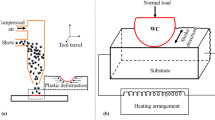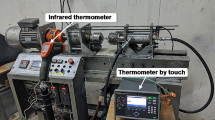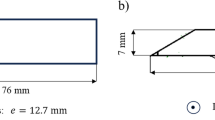The wear resistance characteristics of AISI 51B60H and 30MnB5 steels with different carbon and boron contents were investigated. The analysis of the microstructure and hardness of steels was carried out. The specific wear rates in the conditions of dry and wet friction were calculated, and the friction coefficients were determined. The worn surfaces of rail samples were studied by electron microscopy. The possibility of using boron steels instead of R260 steel, which is used for manufacturing high-speed railways, was considered.









Similar content being viewed by others
References
Y. Song, J. Lu, L. Hua, et al., “Influence of thermal deformation conditions on the microstructure and mechanical properties of boron steel,” Mater. Sci. Eng. A, 701, 328 – 337 (2017).
J. Hardell, E. Kassfeldt, and B. Prakash, “Friction and wear behavior of high strength boron steel at elevated temperatures of up to 800°C,” Wear, 264(9 – 10), 788 – 799 (2008).
J. Hardell and B. Prakash, “High-temperature friction and wear behaviour of different tool steels during sliding against Al – Si-coated high-strength steel,” Tribol. Int., 41(7), 663 – 671 (2008).
E. Kassfeldt and J. Lundmark, “Tribological properties of hardened high strength Boron steel at combined rolling and sliding condition,” Wear, 267(12), 2287 – 2293 (2009).
Y. Zhu, Y. Lyu, and U. Olofsson, “Wear between wheel and rail: A pin-on-disc study of environmental conditions and iron oxides,” Wear, 328, 277 – 285 (2015).
K. Matsumoto, Y. Suda, H. Komine, et al., “A proposal of wheel/rail contact model for friction control,” J. Mech. Sci. Technol., 19(1), 437 – 443 (2005).
H. Hur, J. Park, W. You, and T. Park, “A study on critical speed of worn wheel profile using a scale model,” J. Mech. Sci. Technol., 23(10), 2790 – 2800 (2009).
J. F. Santa, A. Toro, and R. Lewis, “Correlations between rail wear rates and operating conditions in a commercial railroad,” Tribol. Int., 95, 5 – 12 (2016).
F. H. Çakir and O. N. Çelik, “Effect of isothermal bainitic quenching on rail steel impact strength and wear resistance,” Met. Sci. Heat Treat., 59(5 – 6), 289 – 293 (2017).
S. Iwnicki (ed.), Handbook of Railway Vehicle Dynamics, CRC Press, Boca Raton (2006).
U. Olofsson and T. Telliskivi, “Wear, plastic deformation and friction of two rail steels – a full scale test and a laboratory study,” Wear, 254(1 – 2), 80 – 93 (2003).
Y. Zhu, U. Olofsson, and K. Persson, “Investigation of factors influencing wheel–rail adhesion using a mini-traction machine,” Wear, 292, 218 – 231 (2012).
O. Arias-Cuevas, Z. Li, and R. Lewis, “A laboratory investigation on the influence of the particle size and slip during sanding on the adhesion and wear in the wheel–rail contact,” Wear, 271(1 – 2), 14 – 24 (2011).
Q. Y. Liu, W. J. Wang, P. Shen, et al., “Experimental study on adhesion behavior of wheel_rail under dry and water conditions,” Wear, 271(9 – 10), 2699 – 2705 (2011).
Q. Y. Liu, W. J. Wang, H. F. Zhang, et al., “Study on the adhesion behavior of wheel_rail under oil, water and sanding conditions,” Wear, 271(9 – 10), 2693 – 2698 (2011).
A. Ramalho, “Wear modeling in rail-wheel contact,” Wear, 330, 524 – 532 (2015).
A. Ramalho, M. Esteves, and P. Marta, “Friction and wear behaviour of rolling-sliding steel contacts,” Wear, 302(1 – 2), 1468 – 1480 (2013).
W. J.Wang, C. G. He, Y. B. Huang, et al., “Experimental investigation on the effect of tangential force on wear and rolling contact fatigue behaviors of wheel material,” Tribol. Int., 92, 307 – 316 (2015).
W. J.Wang, H. H. Ding, Z. K. Fu, et al., “Investigation on the effect of rotational speed on rolling wear and damage behaviors of wheel_rail materials,” Wear, 330, 563 – 570 (2015).
Y. Zhu, X. Chen, W. J. Wang, and H. Yang, “A study on iron oxides and surface roughness in dry and wet wheel–rail contacts,” Wear, 328, 241 – 248 (2015).
R. Lewis and U. Olofsson, Wheel–Rail Interface Handbook, Woodhead Publishing, Sawston (2009).
M. Pau, F. Aymerich, and F. Ginesu, “Distribution of contact pressure in wheel–rail contact area,” Wear, 253(1 – 2), 265 – 274 (2002).
L. Deters and M. Proksch, “Friction and wear testing of rail and wheel material,” Wear, 258(7 – 8), 981 – 991 (2005).
J. Kabzinski, “Adaptive, compensating control of wheel slip in railway vehicles,” Bull. Polish Acad. Sci., Tech. Sci., 63(4), 955 – 963 (2015).
H. Yokoyama, S. Mitao, S. Yamamoto, et al., “High strength bainitic steel rails for heavy haul railways with superior damage resistance,” NKK Tech. Rev., 84, 44 – 51 (2001).
R. Lewis and E. A. Gallardo-Hernandez, “Twin disc assessment of wheel/rail adhesion,” Wear, 265(9 – 10), 1309 – 1316 (2008).
A. Ramalho and J. C. Miranda, “Friction and wear of electroless NiP and NiP+PTFE coatings,” Wear, 259, 828 – 834 (2005).
J. Zajic, P. Hanus, and M. Schmid, “Assessment of operational hardening of the railway wheels surface layers,” in: 33rd International Colloquium on Advanced Manufacturing and Repair Technologies in Vehicle Industry, Zuberec (2016), pp. 120 – 123.
E. Sheinman, “Wear of rails. A review of the American press,” J. Frict. Wear, 33(4), 308 – 314 (2012).
R. Müller, P. Gratacos, P. Mora, et al., Definition of Wheel Maintenance Measures for Reducing Ground Vibration, Railway Induced Vibration Abatement Solutions Collaborative Project (2013).
Author information
Authors and Affiliations
Corresponding author
Additional information
Translated from Metallovedenie i Termicheskaya Obrabotka Metallov, No. 6, pp. 50 – 60, June, 2020.
Rights and permissions
About this article
Cite this article
Bozkurt, F., Er, Ü. Investigation of Tribological Properties of Rail and Wheel Steels. Met Sci Heat Treat 62, 405–414 (2020). https://doi.org/10.1007/s11041-020-00575-4
Published:
Issue Date:
DOI: https://doi.org/10.1007/s11041-020-00575-4




